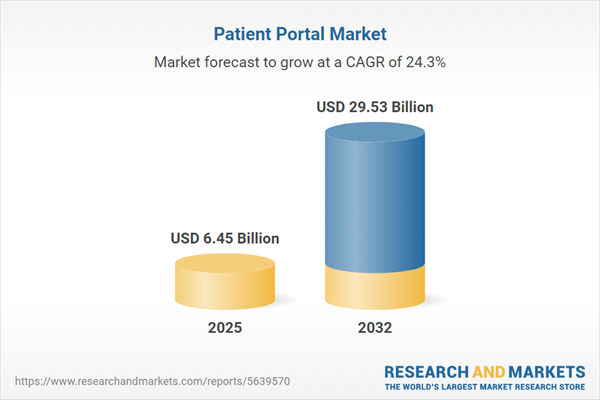Speak directly to the analyst to clarify any post sales queries you may have.
The patient portal market is fundamentally reshaping healthcare IT, enabling more efficient collaboration, engagement, and communication across care organizations. As senior decision-makers look to enhance operational agility, patient portals now provide a secure, interoperable foundation that supports coordinated healthcare delivery and improved patient engagement.
Patient Portal Market Snapshot
The global patient portal market is currently valued at USD 5.19 billion and is projected to reach USD 6.45 billion by 2025. Long-term forecasts indicate growth to USD 29.53 billion by 2032, propelled by a robust 24.27% compound annual growth rate. This momentum is largely attributed to technological innovation in digital interoperability and intuitive portal design focused on end user experience. Government policies increasingly emphasize standardization and integration, empowering healthcare institutions to achieve seamless data exchange. Integration with electronic health record (EHR) systems remains a key driver, while digital security and privacy enhancements facilitate stakeholder trust. As organizations adopt these advanced solutions, the patient portal market continues to experience significant global expansion.
Scope & Segmentation of the Patient Portal Market
- Integration Approaches: Healthcare providers may connect patient portals directly with EHR platforms or operate standalone portal solutions, addressing diverse clinical and administrative requirements across a variety of care settings.
- Delivery Modes: Patient portal solutions are offered via mobile applications on major operating systems and comprehensive web-based interfaces, ensuring consistent data access for inpatient, outpatient, and remote care delivery.
- End Users: Key stakeholders include patients, clinical professionals, nursing staff, and administrative personnel. Each group utilizes portals to support coordinated care, minimize redundancy, and improve workflow efficiency.
- Deployment Models: Organizations can implement cloud-based, on-premise, or hybrid deployments, each aligned to specific privacy preferences, regulatory mandates, and requirements for scale.
- Regions Covered: Growth patterns and adoption strategies vary across the Americas, Europe, Middle East, Africa, and Asia-Pacific. Regional infrastructure maturity and regulatory frameworks often shape investment decisions and technology deployment.
- Leading Companies Analyzed: Vendors such as Epic Systems Corporation, Cerner Corporation, Allscripts Healthcare Solutions, Medical Information Technology, athenahealth, eClinicalWorks, NextGen Healthcare, GE HealthCare Technologies, Siemens Healthineers, and Koninklijke Philips N.V. are central to market evolution and set the interoperability standards that define best practices for the sector.
Key Takeaways for Senior Decision-Makers
- Organizations deploying advanced patient portal solutions achieve more integrated, real-time collaboration across care teams, leading to improved patient experience and enhanced coordination of healthcare services.
- Adopting modular, interoperable technologies allows rapid adaptation to new regulations, minimizing operational disruption during compliance transitions or technology upgrades.
- Modern patient portals increasingly use artificial intelligence to automate administrative workflows, such as appointment reminders and virtual visit management, which streamlines healthcare provision and allows clinical staff to focus on direct patient care.
- Device-agnostic platforms support secure scheduling, encrypted communications, and accessible patient histories. These features promote staff mobility while ensuring care delivery consistency across settings ranging from large hospitals to smaller clinics.
- Partnering with leading solution providers reduces procurement risks, increases responsiveness to shifting regulatory requirements, and ensures organizations are well-positioned to handle upcoming changes in the healthcare policy environment.
Tariff Impact: Navigating the 2025 US Policy Environment
Upcoming US healthcare policies are prompting providers to revise procurement strategies and bolster their domestic supply chain capacity. The adoption of cloud-based deployment models supports rapid operational adaptation and improved regulatory compliance. Establishing partnerships with seasoned technology vendors is increasingly recognized as crucial for maintaining uninterrupted care delivery and effective risk management in a continually evolving policy and regulatory landscape.
Methodology & Data Sources
This market analysis is based on an established research framework, utilizing authoritative market reports, peer-reviewed publications, and targeted interviews with senior leaders in healthcare IT and clinical domains. All findings are cross-validated to ensure strategic accuracy and actionable executive insight.
Why This Report Matters
- Helps senior decision-makers formulate effective digital transformation roadmaps, ensuring full value is realized from patient portal investments and technology upgrades.
- Delivers comprehensive segmentation and identifies emerging trends early, equipping leadership teams to adjust strategic planning in response to technological or regulatory shifts.
- Provides a regulatory compliance framework, supporting institutional resilience as healthcare requirements and operational pressures evolve.
Conclusion
Sustained investment in patient portals and strategic technology partnerships is vital for developing flexible, digitally enabled healthcare operations. These approaches position leadership teams to proactively address emerging clinical, operational, and regulatory challenges.
Additional Product Information:
- Purchase of this report includes 1 year online access with quarterly updates.
- This report can be updated on request. Please contact our Customer Experience team using the Ask a Question widget on our website.
Table of Contents
3. Executive Summary
4. Market Overview
7. Cumulative Impact of Artificial Intelligence 2025
Companies Mentioned
The companies profiled in this Patient Portal market report include:- Epic Systems Corporation
- Cerner Corporation
- Allscripts Healthcare Solutions, Inc.
- Medical Information Technology, Inc.
- athenahealth, Inc.
- eClinicalWorks, LLC
- NextGen Healthcare, Inc.
- GE HealthCare Technologies Inc.
- Siemens Healthineers AG
- Koninklijke Philips N.V.
Table Information
| Report Attribute | Details |
|---|---|
| No. of Pages | 193 |
| Published | November 2025 |
| Forecast Period | 2025 - 2032 |
| Estimated Market Value ( USD | $ 6.45 Billion |
| Forecasted Market Value ( USD | $ 29.53 Billion |
| Compound Annual Growth Rate | 24.2% |
| Regions Covered | Global |
| No. of Companies Mentioned | 11 |









